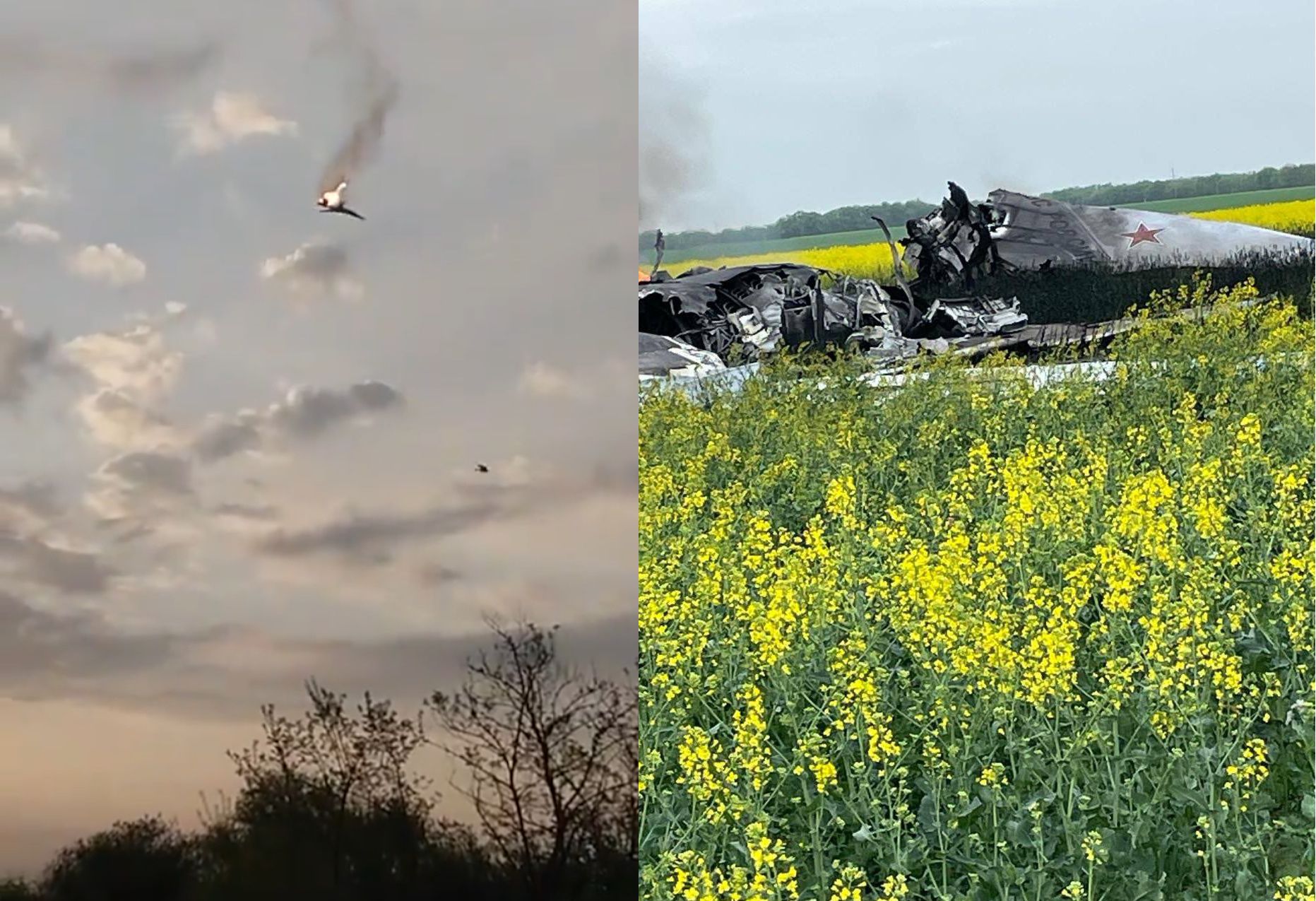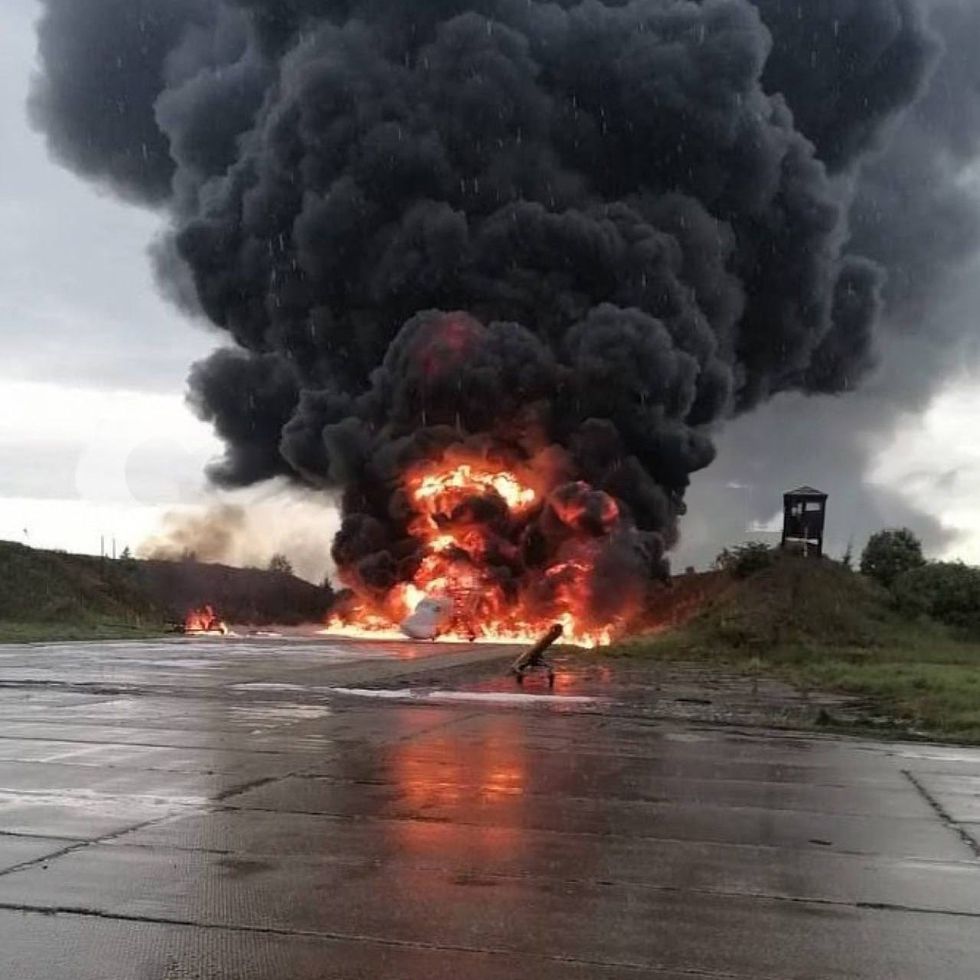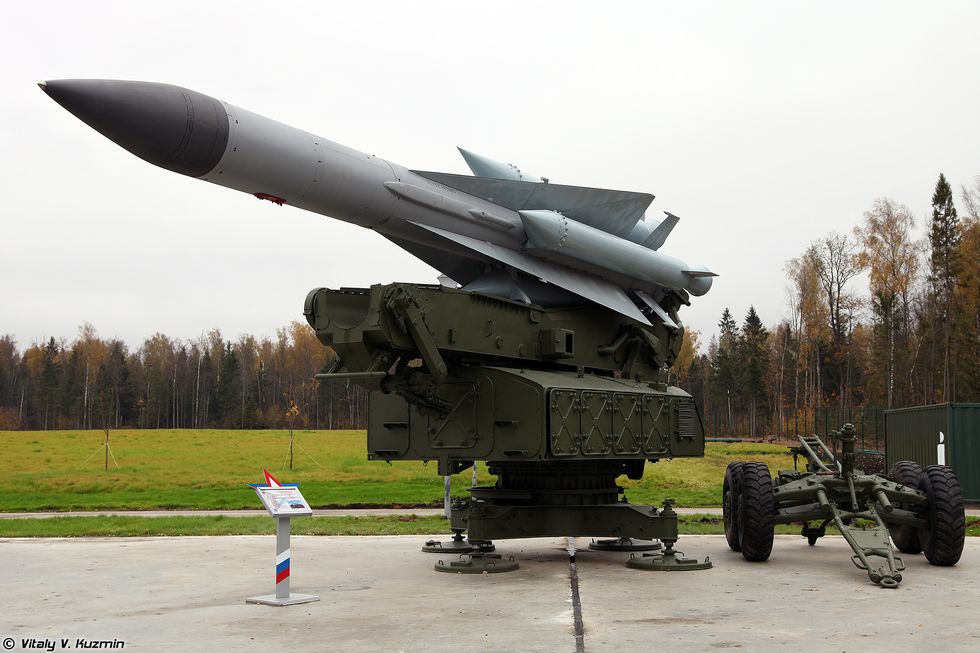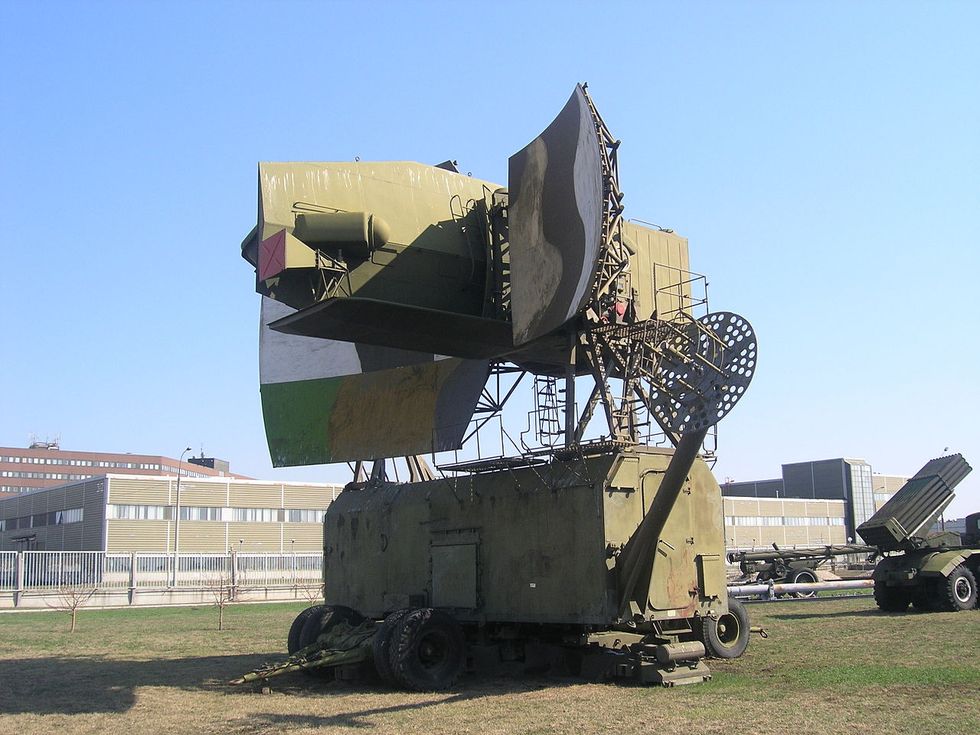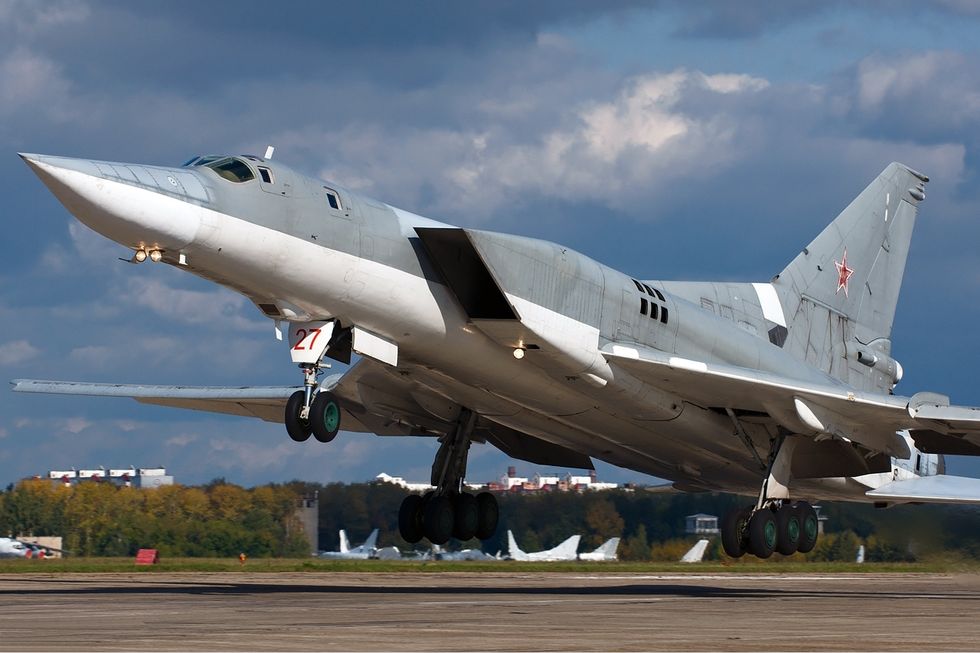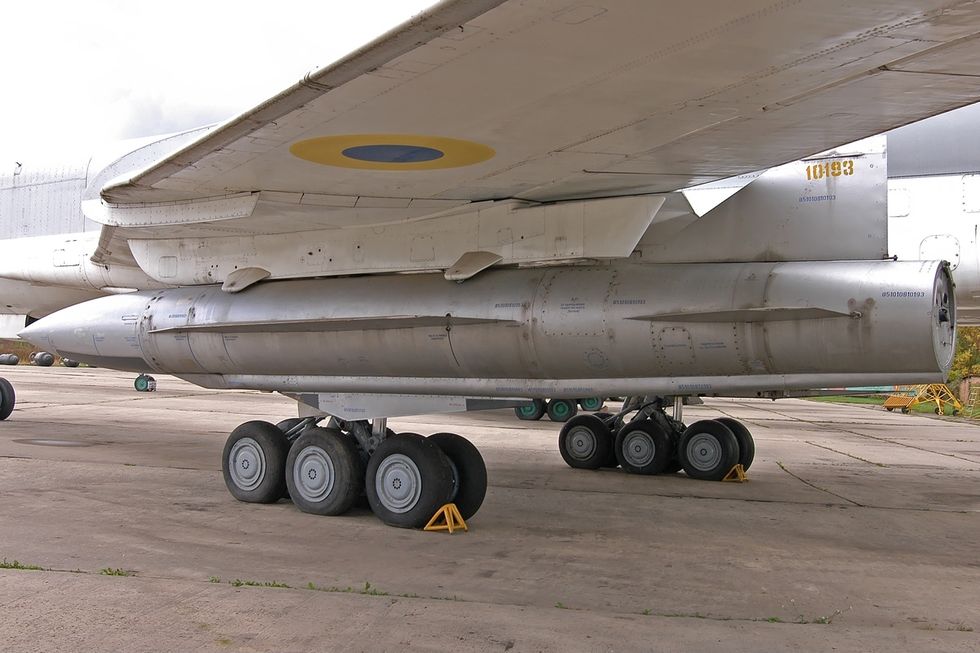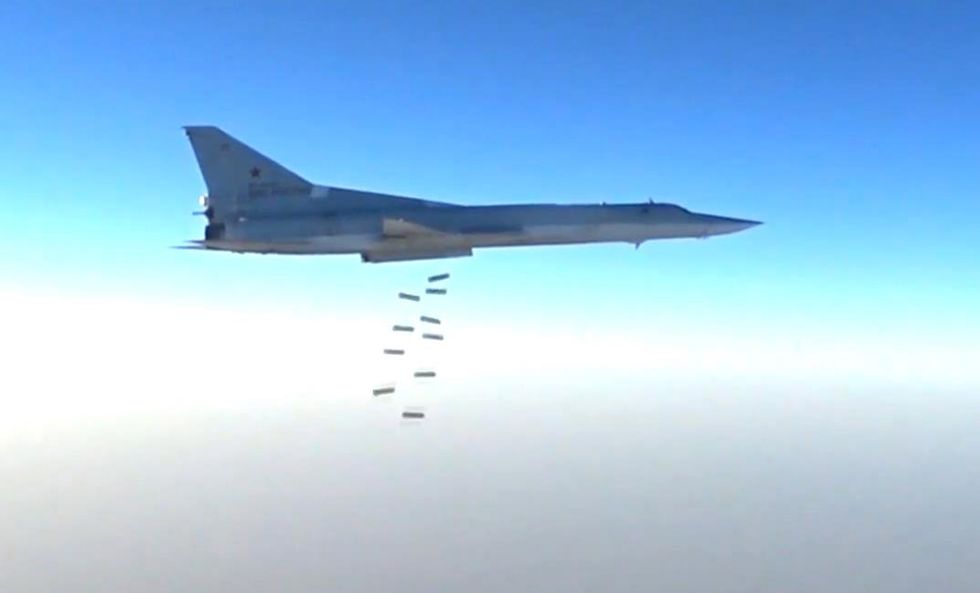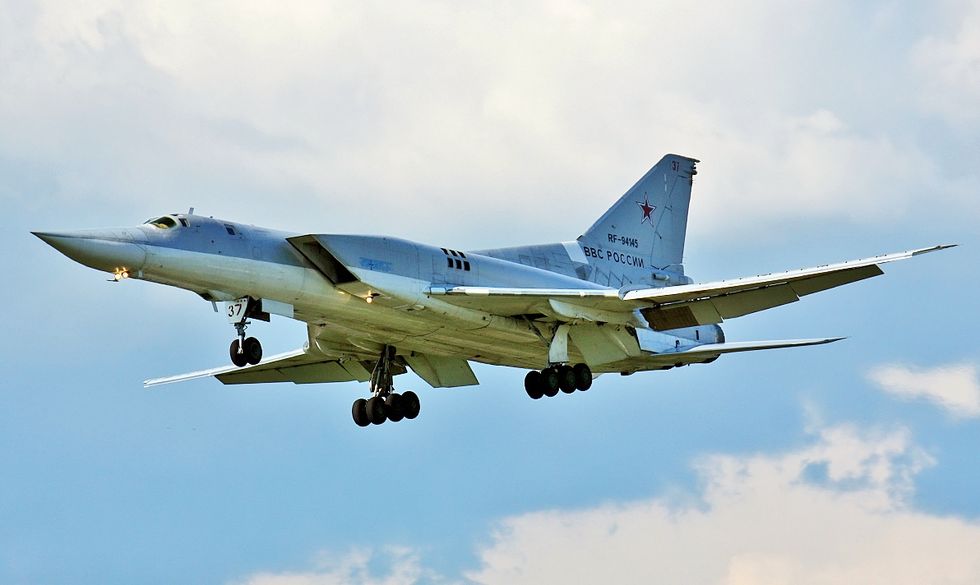It was business as usual for the four-man crew of a RussianTu-22M3 Backfire bomber as it released its supersonic Kh-22 missiles towards a city in southern Ukraine, raining death and destruction from above and very far away.
It was just a matter of taking off and reaching the ideal speed and altitude before launching the powerful weapons, all while remaining safely over Russian airspace or the Black Sea—far away from Ukrainian ground-based air defenses and well shielded from Ukrainian fighters by friendly air defenses.
As the Backfires headed back to base—in this case, likely near Mozdok in North Ossetia, 400 miles away from the Ukrainian border—the Kh-22 missiles (developed 60 years ago by the Soviet Union to sink U.S. aircraft carriers) should have accelerated to over four times the speed of sound and plummeted down on Ukrainian cities, gutting apartment buildings, shopping malls, and even a historic cathedral in Odessa.
But on April 19, something went very wrong for this Backfire’s crew while over the Stavropol region of Russia. Civilian observers recorded the huge bombers ablaze, falling towards the ground in a flat spin.
An attempt to geo-locate the crash site placed it near the village of Bogomolov, at a point roughly 235 miles (379 km) southeast of Ukrainian forces holding out in Vuhledar.
Two or three of the bomber’s four crew were reportedly found alive after ejecting from the aircraft. However, other sources state two of the bomber’s crew did not survive.
Russia claimed some form of technical error had caused the fire on the Tu-22M and its eventual crash, while Ukraine’s military claimed responsibility for the downing, and released footage allegedly from the operations room where the shoot-down was coordinated.
These rival explanations obviously correspond to the preferred narratives of Russia and Ukraine. And given that the Tu-22M3 crashed so far from the nearest Ukrainian-controlled territory, the technical malfunction claim might seem more plausible on the surface.
But there was already a reason to suspect Ukraine might have pulled off a record-setting attack. Two months earlier, on February 23, one of Russia’s few and highly valuable A-50M Mainstay airborne early warning jets was also shot down over Russian soil—and it was soon was indicated that Ukraine had pulled its old but powerful Soviet S-200V Vega-M air defense system out of mothballs to execute the long-range attack.
Indeed, Budanov—the head of Ukraine’s GUR military intelligence agency—eventually told media that the attack had involved a roughly 308km (191 mile) range shot using an S-200 system, and that the ambushing battery spent over a week lying in wait. The crippled bomber managed to traverse roughly 60 more miles before crashing near Stavropol. Reportedly, the downing compelled a second Backfire bomber to abort its mission without having launched its missile payload (which ordinarily has a generous standoff range of 370 miles).
The incident marks the first strategic bomber Russia has lost in the over two-year war while in flight, though another Tu-22M was destroyed by a Ukrainian drone attack at Soltsy Airbase in August of 2023.
And if the Ukrainian account is accurate—British intelligence states that the claim is “almost certain”—Ukraine’s air defense troops may have achieved the longest-range shoot down of a manned aircraft in combat, breaking records set earlier in the war by Russia’s advanced R-37M air-to-air missile and S-400 surface-to-air missile systems (launched from 110 and 93 miles away, respectively). And Ukraine did it with a big, clunky weapon that entered Soviet military service nearly 60 years ago.
How could Ukraine’s pull off an Olympic-level long-distance shot?
You can read Popular Mechanic’s earlier in-depth profile of Ukraine’s S-200V systems here. But here’s a quick recap: the beefy S-200, codename SA-5 Gammon by NATO, entered Soviet service in the 1960s to threaten (over very long distances) NATO bombers traveling at very high altitudes and speeds up to Mach 3. The most common S-200M ‘Vega’ sub model teamed a more jam-resistant 5N62 ‘Square Pair’ targeting radar with the 8-ton V-880 missiles, which accelerate to Mach 8 speeds and are boosted by four jettison-able solid-fuel rocket boosters that supplement its main, liquid-fuel motor.
The V-880 (also designated 5V28) relied on ground-based radar to continuously ‘illuminate’ targeted aircraft for its passive radar receiver to latch onto. Despite being obsolete compared to the U.S.-built Patriot batteries guarding Ukrainian airspace, the V880 still boasts nearly twice the maximum range of those batteries.
Ukraine retired its last five S-200V brigades/regiments in 2013—ironically just before Russia’s first invasion the following year. This spurred a Ukrainian effort to reintroduce the last 3-4 useable S-200 batteries in storage back into service, despite lacking access to missile parts.
Ukraine didn’t appear to have S-200s operational when Russia invaded in 2022, but in 2023, evidence emerged that the country had begun using V-880s as ground attack ballistic missiles targeting the Crimean bridge and the town of Bytosh in Bryansk.
Then, in February, one of Russia’s handful of operational A-50M AWACS planes was shot down over over Krasnodar Krai, Russia near the Sea of Azov. Ukrainian sources reported that an S-200 had executed this very long-range kill, meaning it had returned to its original air defense role. Ukraine actually also claimed the downing of another A-50 over the Sea of Azov (also presumably using S-200) on January 14, but without confirmable evidence.
On paper, the S-200’s official max range of 150 miles falls short of the rough 250-mile distance of the crashed Tu-22M. But Wen Jian Chung, an expert on Soviet-legacy military systems and author of several books on Ukraine, pointed out recently on social media that the ultimate S-200D ‘Dubna’ model of the S-200 system did officially have a range of 186 miles. Chung also mentioned a tragic incident from October of 2001 in which, during a joint air defense exercise with Russia, a Ukrainian S-200 battery accidentally destroyed a Tu-154 airliner 217 miles southeast of the closest Ukrainian soil in Feodosia, Crimea. The destruction resulted in the death of all 86 passengers and crew.
This tragedy illustrates that official maximum ranges are, at best, simplified approximations of what is actually kinetically possible. In reality, an intercept’s effective maximum range is heavily affected by the vector, speed, and altitude of a targeted aircraft in relationship to the launcher, as well as whether and when the aircraft’s crew has a chance to detect and evade the missile before it strikes.
Furthermore, a Ukraine official reportedly said that this S-200’s guidance system had been upgraded with help from presumably foreign “partners,” though the missile maneuvering system itself didn’t require alteration. These modifications might have involved the installation of an infrared or active radar-seeker for terminal guidance upon closing with the bomber, and/or the installation of a datalink allowing for mid-course and perhaps even terminal course corrections based on cuing that was relayed by multiple radar systems.
There are also non-cost-prohibitive tricks for extending the range of the missile itself, such as swapping in a smaller warhead or substituting heavy metal components with lightweight, heat-resistant materials. Such weight reductions allow the same missile to achieve greater speed and range.
There’s still no denying that a shot at the extreme end of both the radar’s and missile’s ranges would be very tricky to pull off, and likely required a combination of Russian bombers flying in a predictable pattern (which allowed Ukraine to prepare an ambush) and waiting for the perfect shot to line up.
Even then, it’s surprising that the missile wasn’t detected in time for the Tu-22M3 to evade, and that its electronic warfare self-defense system proved ineffective. Unlike Russia’s Tu-95 Bear bombers, the Backfire is capable of sprinting to supersonic flight, and could likely have raced beyond the missile’s no-scape zone given adequate forewarning. Even Russia’s ground-based air defenses might have had a shot at both detecting and shooting down the large—but admittedly very fast—V-880 missile before it could reach the Backfire.
That suggests there might have been a vulnerability in Russian air defense coverage, and the warning systems on the Backfire in particular. Some analysts speculate that the bomber’s defensive jammers may have lacked efficacy against the Square Pair radar, or may even have been turned against it as S-200 systems also have ‘home-on-jamming’ capabilities.
It’s also worth recalling that Russia lost a Tu-22M3 reconnaissance variant of the Backfire bomber to a Georgian Buk-M1 air defense system during their 2008 invasion of Georgia.
In one sense, the material loss of a bomber is the same whether it’s due to technical problems or enemy fire. But if Ukrainian missiles are responsible, that may affect Russia’s bomber operations going forward. It could compel greater caution, which might include basing the aircraft further away (despite added fuel consumption) and redeploying air defenses and electronic warfare systems from the frontline to rear-area air defense, rendering Russia’s strategic missile campaign less efficient.
Ukraine’s apparent long-range kill serves as a reminder that in the technology-dominant context of aerial warfare, innovations and tactics can abruptly disrupts seemingly safe routines, making complacency a risk factor when facing a smart and adaptable enemy.
Unfortunately, Russia managed a similar feat with recent missile strikes that apparently destroyed or damaged three or four Ukrainian MiG-29 short-range fighters (on the ground at a frontline airbases) and ground-based air defenses. The attack was evidently cued via a deep-penetrating surveillance drone (the one recording the strikes), and apparently involved Iskander tactical ballistic missiles full of cluster submunitions. These attacks, too, may force Ukraine to reconsider how it deploys fighters at forward airfields.
Russia’s Shrinking Fleet of Backfire Bombers
Introduced into Soviet service in the 1970s, the Tu-22M (codenamed ‘Backfire’ by NATO) was actually an entirely different design from the preceding Tu-22 ‘Fitter’ supersonic bomber, but was sold as a modernization of the latter for political reasons. Sporting two NK-25 after-burning turbofan engines for propulsion, the Tu-22M also had swings wings that could either be tucked in to minimize drag for supersonic flight (max speed Mach 1.88), or extended to maximize lift and low-speed handling during takeoff and landing.
However, Backfires were stripped of their nose-mounted refueling probes for compliance with arms control treaties pertaining to strategic weapons, limiting their ranges compared to Russia’s turbo-prop powered Tu-95 Bear and supersonic Tu-160 Blackjack bombers. Many of the 497 Backfires built were also plagued by severe manufacturing defects leading to abysmal serviceability rates and spare parts shortages. Additionally, the Tu-22M proved difficult to fly and to land, and the crew of four—pilot, co-pilot, navigator, and weapons officers—lacked good visibility from the cockpit.
During the Cold War, the Backfire’s primary mission was to be deployed en masse to destroy U.S. Navy carrier taskforces, with each bomber slinging either 2-3 long-range Kh-22 anti-ship missiles (optionally with nuclear warheads), or six smaller Kh-15s. That meant a heavy bomber regiment of 24 Backfires could, in theory, simultaneously launch 72 supersonic missiles—all potentially armed with nuclear warheads—on U.S. carrier groups.
It’s worth noting that Ukraine’s Air Force at one point retained 60 Tu-22M2 and M3 Backfire bombers inherited from the Soviet Union but 423 Kh-22 missiles, but these were all scrapped by 2006 in accordance with the U.S.’s Nunn-Lugar strategic arms reduction agreement.
Despite being designed for such high-tech missile warfare at sea, until recently, the Tu-22M’s actual combat service principally saw it used as World War II-style level bomber dropping unguided bombs. It was used to bombard Mujaheddin positions and fortifications in Afghanistan in 1984, then Chechen rebels during Russia’s failed 1994-1995 Chechen war.
Backfires were also active during Russia’s 2008 invasion of Georgia, where one Russian Tu-22M3 was downed by a Buk-M1 system at medium altitude and lost 2 out of 4 crew—resulting in the type’s withdrawal from subsequent operations. Backfires based in Russia (and, for one week, in Iran, in violation of that country’s constitution) also cluster-bombed urban centers and refugee camps in rebel-held regions of Syria during the mid-2010s—by then, increasingly using the SVP-24-22 Hephaestus satellite-based attack-navigation system to time unguided bomb releases.
True to prior practice, once Russia managed to surround the coastal port of Mariupol in 2022 and suppress nearby air defenses, Backfires carpet bombed the city’s defenders, holding out in the Azovstal factory. But those missions were exceptional, as Ukrainian air defense threats remained too powerful everywhere else for level bombing at medium-altitude to be viable.
So, Russia began loading old Kh-22 missiles onto Backfires and having bombers hurl them from afar at Ukrainian cities, whereupon their primitive radar seekers would latch onto whatever large buildings presented themselves. Due to Mach 4.6 peak speeds, the Kh-22 is very difficult for Ukrainian defenses to intercept—though reportedly, on the same day the Tu-22M3 was shot down, Ukraine managed to intercept Kh-22 missiles for the first time as well.
Russia began its invasion with just over 60 Tu-22Ms. Now, at least two have been confirmedly destroyed, and at least two more have been confirmed damaged on the ground by Ukrainian drones attacks at Soltsy and Dyagilevo airbases (with possibly two more damaged at Shakovka).The Military Balance 2024 currently assesses that Russia’s air force retains 57 Tu-22M3s.
The Backfire is no longer in production, though plans to upgrade up to 30 Backfires to improved Tu-22M3M models are slowly crawling forward, with at least four reportedly delivered since 2018. The M3M sports the more powerful NV-45 radar and NK-32 turbofans, new digital avionics and electronic warfare systems, and support for Kh-32 cruise missiles (based on the Kh-22, but with a jam-resistant radar seeker and uprated engine that gives it greater range of 620 miles).
Sébastien Roblin has written on the technical, historical, and political aspects of international security and conflict for publications including 19FortyFive, The National Interest, MSNBC, Forbes.com, Inside Unmanned Systems and War is Boring. He holds a Master’s degree from Georgetown University and served with the Peace Corps in China. You can follow his articles on Twitter.
